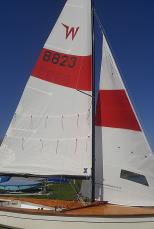 Full sail |
The ALS mainsail reefing system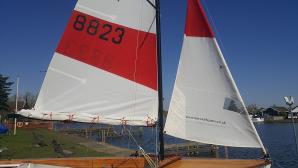 Double reefed – both mainsail and genoa |
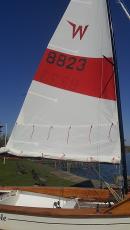 First reef in main |
Reefing options for the tack |
||
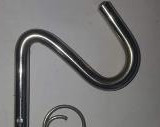 |
|
|
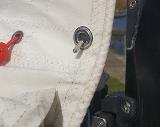 |
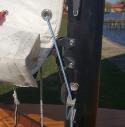 | |
Reefing options for the clewBoom Slide Reefing Blocks There are a number of options for reefing the mainsail clew. The simplest (and easiest to adjust for the correct position, so that the clew reefing line is pulled equally both down and back, forming an angle of around 45°), are the boom slide reefing blocks. This can be a single block, with the reefing line operated from one particular side of the boom, or, if reefing is likely to be carried out whilst afloat, a double boom slide reefing block, which allows the reefing line to be operated on either side of the boom. The forward end of the clew reefing line is secured by a Clam Cleat and Cleat Keeper. The Cleat Keeper allowing the line to be secured more positively, as well as ensuring that the line doesn’t catch in the cleat whilst taking out the reef. The Clam Cleats should be fitted around 300 to 400mm from the front end of the boom, to enable the crew to comfortably operate the reefing line from the crew’s quarters, and only need to be fitted on one side of the boom for a single block reefing system, or both sides for a double block reefing system. | ||
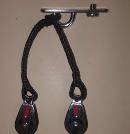 |
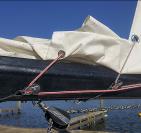 |
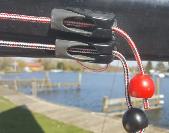 |
Other options |
||
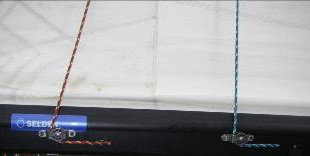 |
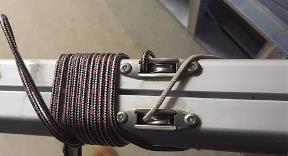 |
|
Cheek Blocks: These are fixed to the boom, with the reefing lines running either externally, or internally by drilling a hole in the boom 75 to 100mm from the cheek block. The advantage of running the line internally is that it can be brought out at a point on the underside of the boom beyond the kicking strap fixing, allowing the reefing line to be easily accessed whichever side of the boat the boom is on when reefing afloat. The disadvantage of this system is the care that is needed to position the cheek blocks correctly before drilling the required holes to fit them. ALS Ltd use the boom slide reefing blocks to determine this position when asked to fit either this set up, or the through deck sheaves. Through Deck Sheaves: More work on the boom is required to fit Deck Sheaves, as a slot for the sheave needs to be cut into the boom, as well as the holes drilled for the fixing screws. Again it is essential to ensure the sheave is correctly positioned prior to cutting into the boom. Boom slide blocks led aft to plastic sheaves at the end of the more recently designed boom: This set-up has the advantage of being easily adjustable for the correct clew reefing line angle, as well as the lines being led internally without needing to drill any holes in the boom. However, where a sail has 2 reefing points, it would be necessary to cut a slot near the rear end of the boom for a through deck sheave, which could then be used for the sail’s clew outhaul. Leech reefing cringles Where a mainsail is likely to be reefed afloat, it is advisable to have 2 reefing cringles fitted along the leech of the sail, equally distanced between the sail’s clew cringle, and the first reefing cringle. The clew reefing line is then passed through each of these 2 cringles, before being threaded through the first reefing cringle. The leech of the main will then be concertinaed neatly at the clew after reefing the sail, thereby tidying up the leech of the main, since this would not be possible to reach afloat in order to secure the (elastic) reefing ties. |
||
Tidying up the mainsail after reefing |
||
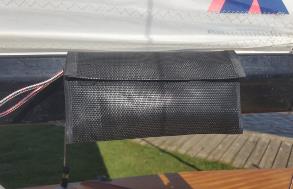 |
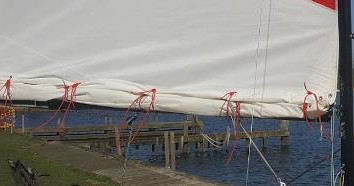 |
|
The loose foot of the sail is then gathered and rolled up against the boom, with elastic reefing ties being used to keep the loose foot against the boom. These can be supplied by ALS Ltd as double sided ties, with the line from the far side of the sail being fitted through the Tyga Tie on the facing side. These ties need only be fastened as far as the crew can comfortably reach form the crew’s quarters when reefing afloat. An ALS Ltd reefing line boom bag – ideally with one fitted on each side if reefing afloat – can be used to keep the spare reefing line tidy. |
||
Video of Matt Sharman demonstrating the mainsail reefing process |
Illustrated in the photo below is a Wayfarer sailing comfortably with 2 reefs in the mainsail and a reefed genoa, on a cold February day in the F5 wind conditions. The clearly visible sailhead buoyancy bag is fully inflated, which would prevent the boat from inverting – even with 2 reefs in the mainsail. |
|
The distinctive red panel in the sail - making the boat more visible as a safety factor, (as seen by the photo of the Wayfarer in the background) - is an optional feature with new McNamara sails. | |
Ansis Rozkalns and Brian Alexander sailing W8823 on a UKWA organised event at Brancaster, Norfolk. |
|


